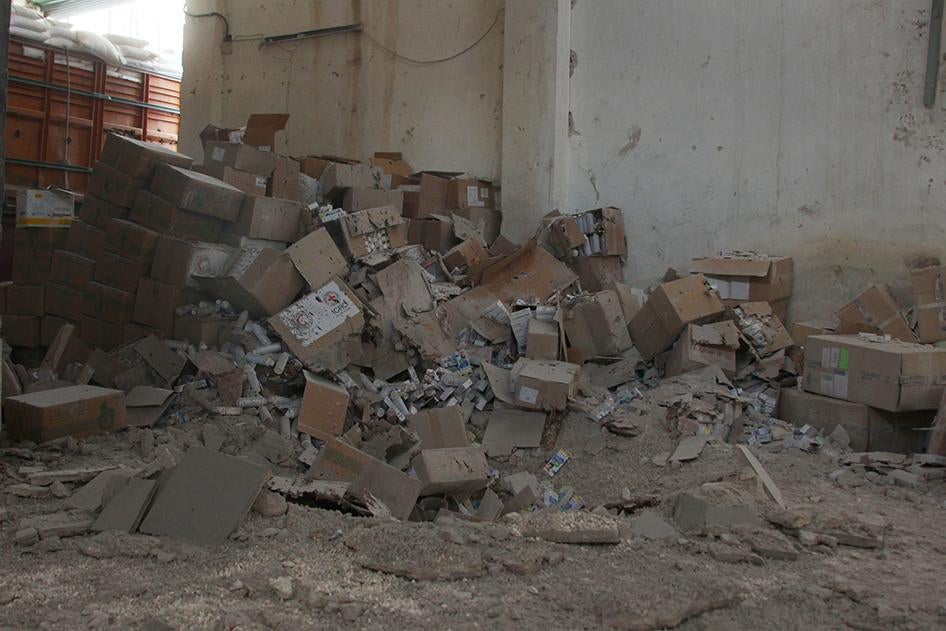(New York) – An attack on a United Nations aid convoy and on a Red Crescent warehouse in Aleppo should be investigated as possible war crimes. The apparent airstrikes on September 19, 2016, hit the convoy and building for over three hours with no military targets in the vicinity. The attacks violate the laws of armed conflict and would constitute war crimes if they intentionally targeted personnel, vehicles, or installations involved in providing humanitarian assistance. Only Syrian and Russian air forces are known to be active in this part of Syria.
In a statement on September 19, the UN Office for the Coordination of Humanitarian Affairs said that the UN-Syrian Arab Red Crescent convoy was hit in Urum al-Kubra, southwest of the city of Aleppo. A Red Crescent warehouse was also hit and a health clinic operated by the Red Crescent was damaged, the organization said. It said that 20 civilians and one staff member were killed as they unloaded trucks, and that most of the aid, including food and medical supplies that was meant to help at least 78,000 people, was destroyed. The UN said that the convoy had received proper permits from the Syrian government in advance to cross from government-controlled Aleppo to parts of opposition-held western Aleppo to deliver the aid.
“The apparent targeting of a humanitarian convoy that had been cleared to operate and a known aid warehouse raises serious questions about whether the strikes were intentional,” said Lama Fakih, deputy Middle East director. “An independent UN-led investigation is needed to determine if this was a deliberate attack on civilians.”
Human Rights Watch called on the UN secretary-general to announce at a high level session of the Security Council set to meet on September 21, that he will promptly seek to identify the parties responsible for the attack and report back to the Council.
In a statement released on September 20, the Syrian Arab Red Crescent announced that the head of the Urum al-Kubra branch, Omar Barakat, was killed in the attack and that the organization would suspend its activities in Aleppo for three days.
The Russian government denied its or the Syrian government’s involvement in the attack in a statement released on September 20, even though witnesses told Human Rights Watch the attack was by air, and they are the only parties to the conflict known to carry out aerial attacks in those areas. Ahmad al-Ahmad, a local journalist, was in the area the night of the attack and told Human Rights Watch that the warehouse was known to be a Red Crescent building:
The warehouse was far away from any front line or military headquarters. The attack lasted until 10:30 p.m. The Urum-Aleppo-Kafarnaha road was under heavy fire with missiles. Rescue workers couldn’t get in to rescue people. One said to me late at night, “Ahmad, we’re under fire, we can’t go in, we can’t rescue anyone.” We arrived the next morning and they began to pull people out. It was unimaginable. Remains were scattered everywhere. Buildings, vehicles, everything was charred. People, however, saw many surveillance planes in the sky that evening.
Ammar al-Salmo, a member of the volunteer search-and-rescue crew known as the Syrian Civil Defense, was also in the vicinity of the attack and told Human Rights Watch that the attack started at 7:10 p.m.:
We heard helicopters in the air just before the attack. There were 31 aid trucks that were unloading aid at the time. The fires and strikes were so bad that we weren’t able to even start a response to save people until 3 in the morning. That’s when we started to pull out the deceased from under the rubble. The warehouse is on a highway and it is known to everyone in Urum al-Kubra and the area that this is a Red Crescent warehouse and there are no military bases around it.
Human Rights Watch reviewed more than 10 photos of the aftermath of the attack that showed injured and dead civilians, huge fires engulfing buildings, damaged trucks filled with what seemed to be food and other supplies, and people showing logos of the Red Crescent and UN agencies on damaged supplies.
Security Council Resolution 2254, adopted on December 18, 2015, called on all parties to the conflict in Syria to “immediately cease any attacks against civilians and civilian objects as such, including attacks against medical facilities and personnel, and any indiscriminate use of weapons, including through shelling and aerial bombardment.”
On September 10, the United States and Russia brokered a seven-day cease-fire, which largely held and resulted in a decrease in civilian casualties. But the parties were not able to take advantage of the calm to deliver aid into besieged areas like eastern Aleppo. The Syrian government called off the cease-fire earlier on September 19, even though the US and Russian governments did not announce an end to the cease-fire.
Human Rights Watch has documented previous possible unlawful US airstrikes in Syria in 2014, when US missile strikes on Idlib killed at least seven civilians.
Under the Rome Statute of the International Criminal Court, “intentionally directing attacks against personnel, installations, material, units or vehicles involved in a humanitarian assistance … mission” is a war crime, as is intentionally directing attacks against the civilian population.
“Whether the cease-fire collapses or is revived, key backers of the negotiations should ensure that protecting civilians remains a priority,” Fakih said.








